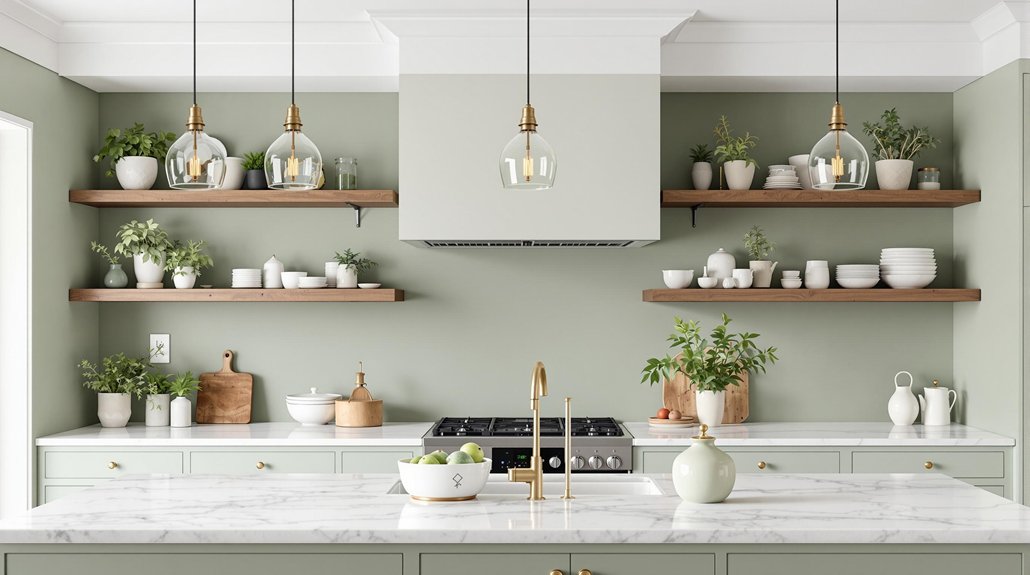
18 Sage Kitchen Decor Ideas That Are Subtle, Stylish, and Serene
Sage kitchen decor blends tranquil green cabinetry, backsplashes, and integrated appliances for seamless serenity. Neutral countertops and natural wood elements provide balanced contrast while layered textures from textiles and woven baskets enhance visual depth. Open shelving and sage window treatments introduce functional softness and curated displays, while subtle sage accents extend to bar stools, lighting, and painted walls. Consistency in palette unifies the aesthetic, with thoughtful layering ensuring harmony. Explore all 18 refined ideas to design a truly sophisticated, serene space.
Key Takeaways
- Sage green cabinets create a calming focal point and timeless appeal without overwhelming the kitchen space.
- Pair sage green cabinetry with neutral countertops like white marble or grey quartz for a serene, balanced look.
- Incorporate sage green backsplashes or painted walls to add subtle color and unify the kitchen’s aesthetic.
- Add visual interest with sage green accents on bar stools, textiles, or lighting fixtures for a cohesive design.
- Blend natural textures like wood, woven baskets, and ceramic dishware with sage green elements for organic sophistication.
Sage Green Cabinets for a Timeless Appeal
Sage green cabinetry introduces a tranquil, sophisticated element to kitchen interiors, establishing a calming ambiance that supports both relaxation and functionality. The muted green hue of sage green cabinets infuses the space with a serene quality, promoting comfort while serving as a subtle yet enchanting visual anchor. This cabinetry finish seamlessly adapts to both shaker-style and flat-panel designs, offering versatility that appeals to advocates of modern elegance and those drawn to more classic motifs. By embracing sage green cabinets, designers achieve an enduring, timeless appeal that transcends fleeting trends. The color’s inherent adaptability guarantees compatibility with diverse kitchen styles, from contemporary minimalism to traditional warmth. Sage green’s understated presence enhances the kitchen, turning cabinetry into a sophisticated focal point without overwhelming the visual surroundings. In a similar way, greige color schemes balance gray and beige for inviting environments, ensuring timeless appeal and versatility in kitchen design.
Neutral Countertops to Complement Sage Green
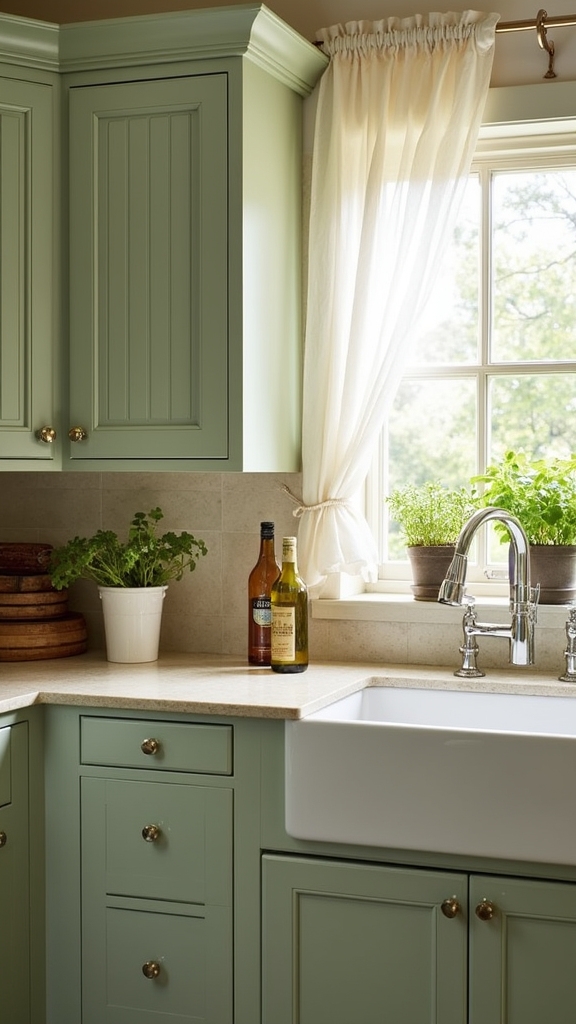
Selecting neutral countertops—such as quartz, marble, or butcher block—strategically amplifies the calming effect of sage green cabinetry.
These materials introduce sophisticated textures and reflective qualities, ensuring both visual harmony and practical resilience in the kitchen environment.
Ideal Countertop Material Choices
When choosing countertop materials to pair with sage green cabinetry, neutral surfaces such as quartz, marble, and butcher block stand out for their ability to enhance both aesthetic appeal and functionality.
White marble countertops offer a luminous, reflective quality that brightens the environment and creates a crisp contrast against sage green kitchen cabinets.
Grey quartz surfaces lend a contemporary, streamlined look while guaranteeing durability and ease of maintenance.
For those seeking tactile warmth, butcher block countertops introduce organic texture and establish a cozy atmosphere, harmonizing with the soothing undertones of sage green.
Subtle veining or fine-grained patterns in these neutral countertops provide visual interest without disrupting the room’s serenity.
Opting for light or muted finishes guarantees that sage green remains the visual cornerstone within the kitchen.
Enhancing Sage Green Cabinets
Neutral countertops serve as the ideal foundation for highlighting the distinctive character of sage green cabinetry. In kitchen decor rooted in minimalist design, surfaces such as white marble, grey quartz, and butcher block introduce refined contrast while maintaining visual tranquility. White marble amplifies natural light, enhancing the calming palette of sage green cabinets. Grey quartz delivers both durability and a sleek, understated appearance, ideal for high-traffic culinary spaces. Butcher block countertops evoke warmth, providing tactile and visual texture that pairs seamlessly with sage green’s organic undertones. Subtle veining or patterns in neutral countertops can further enhance the composition without overwhelming the cabinetry. The following table outlines key attributes:
| Countertop Type | Visual Impact | Functional Benefit |
|---|---|---|
| White Marble | Reflective, airy | Brightens the space |
| Grey Quartz | Modern, subtle | Durable, low-maintenance |
| Butcher Block | Warm, textured | Inviting, tactile |
| Light Granite | Serene, clean | Stain-resistant |
| Soft Veining | Elegant detail | Visual interest |
Sage Green Backsplash for a Pop of Color
Introducing a sage green backsplash provides a subtle yet invigorating pop of color, balancing visual appeal with a tranquil ambiance in the kitchen.
In a modern kitchen, this design element introduces a soft, serene atmosphere that remains visually compelling without dominating the space.
Select from classic subway tiles, intricate mosaic patterns, or contemporary peel-and-stick formats to best suit installation preferences and design objectives.
Choose from subway tiles, mosaic patterns, or peel-and-stick options to match your installation needs and achieve your desired kitchen look.
Utilizing a range of sage green shades within the backsplash composition creates depth and dimension, contributing to a harmonious color scheme.
The sage green backsplash also coordinates effortlessly with stainless steel or matte black hardware, further enhancing the kitchen’s aesthetic.
Adding textured accents, such as exposed brick or wood paneling, can enhance visual depth and warmth, complementing the sage green backsplash beautifully.
Open Shelving With Sage Green Accents
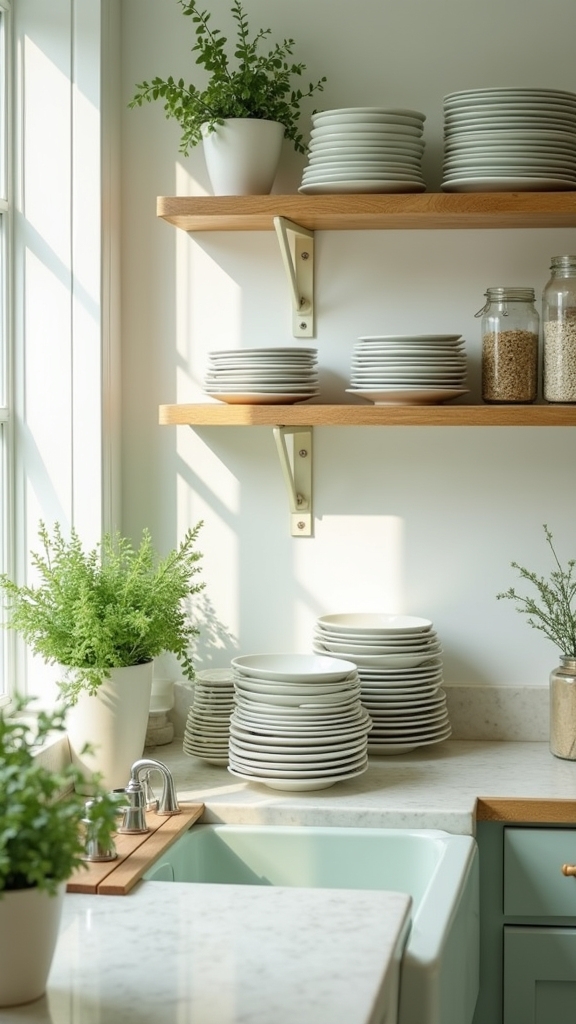
How can a kitchen achieve both functional efficiency and aesthetic appeal? Open shelving with sage green accents presents a solution that merges accessibility with visual harmony.
By installing open shelving, kitchen essentials remain within immediate reach, streamlining workflow while promoting organized storage. Sage green accents introduce a calming chromatic element, offering subtle color without overwhelming the space.
This design strategy allows for the curated display of decorative dishware, cookbooks, and botanical elements, transforming everyday items into visual features. Expertly coordinated with cabinetry or wall finishes, sage green open shelving establishes a cohesive look, unifying disparate kitchen components.
The versatility of sage green complements a spectrum of design styles, from contemporary to rustic farmhouse, making it a universally adaptable choice for those seeking both practicality and design cohesion.
Sage Green Appliances for a Coordinated Look
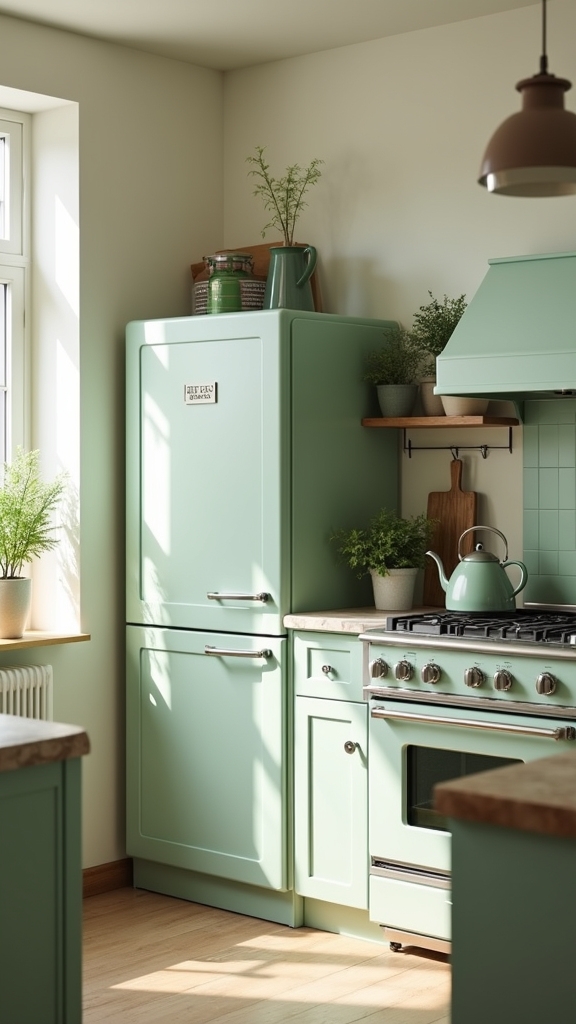
Integrating sage green appliances achieves seamless color continuity, ensuring visual cohesion throughout the kitchen space.
When paired with matching cabinetry, these appliances foster a unified aesthetic that exemplifies modern designer appeal.
The result is a functional environment where style and utility are harmoniously balanced.
Seamless Color Integration
Sage green appliances serve as an effective anchor for seamless color integration in kitchen design, establishing visual cohesion when coordinated with matching cabinetry. In sage green kitchens, integrating appliances with green cabinetry guarantees a unified aesthetic that feels both intentional and sophisticated. Utilizing neutral tones such as white or cream in surrounding elements further enhances the serenity of the palette, preventing the space from feeling saturated. Accentuating with metallic finishes—like brass or stainless steel—introduces a layer of modern design, enhancing both function and visual appeal. This approach not only aligns with current trends but also results in a fresh, inviting environment.
| Design Element | Functional Benefit |
|---|---|
| Sage green appliances | Visual cohesion |
| Neutral tones | Balanced color scheme |
| Metallic accents | Modern aesthetic |
Appliance and Cabinet Harmony
Cohesion emerges in kitchen design when appliances mirror the cabinetry’s sage green hue, establishing a deliberate visual unity across major surfaces.
In a sage green kitchen, integrating appliances such as refrigerators and dishwashers in matching tones reinforces this harmony, producing a seamless flow between functional zones.
The strategic use of sage green for both cabinets and appliances creates a balanced composition, avoiding visual fragmentation often caused by disparate finishes.
Accents in white or stainless steel can punctuate the design, introducing contrast while preserving the serene atmosphere.
This approach maintains a consistent color narrative, enhancing the kitchen’s modern sensibility.
Employing sage green appliances not only amplifies aesthetic appeal but also fosters an inviting environment that feels both curated and tranquil, reflecting refined contemporary design principles.
Modern Designer Appeal
When appliances adopt the same sage green finish as cabinetry, the result is a visually unified kitchen that exemplifies modern designer appeal. Integrating sage green refrigerators, dishwashers, and ovens with cabinetry creates a sage green kitchen that reinforces clean lines and a cohesive aesthetic. This modern design strategy leverages the earthy feel of sage green to seamlessly blend appliances and cabinetry, producing a calming, sophisticated effect. Pairing these elements with neutral countertops such as white marble or grey quartz further enhances the visual clarity. Strategic hardware choices—brass or matte black—contribute to a curated and elegant finish, ensuring the kitchen’s coordinated look is both functional and striking.
| Element | Material/Finish | Visual Impact |
|---|---|---|
| Appliances | Sage Green | Unified, Modern Design |
| Countertops | White Marble/Quartz | Balances Earthy Feel |
| Hardware | Brass/Matte Black | Accentuates Clean Lines |
Sage Green Lighting Fixtures for Ambiance
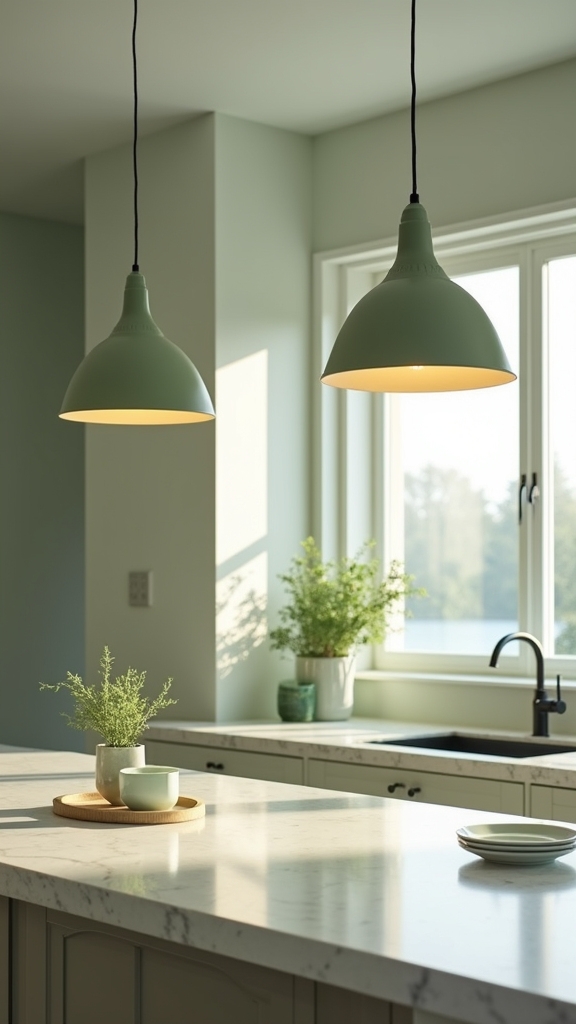
Although often overlooked as mere functional additions, lighting fixtures in a sage green finish operate as both luminaires and integral design accents within the kitchen environment.
Sage green lighting fixtures—ranging from contemporary pendant lights to refined wall sconces—introduce a subtle pop of color while reinforcing an elegant aesthetic. Their chromatic presence enhances ambiance by casting a warm, inviting glow that harmonizes with cabinetry and surrounding décor.
Diverse in form, these fixtures provide opportunities for personalization, from geometric minimalism to vintage-inspired silhouettes. Their strategic placement not only optimizes illumination but also visually anchors the kitchen’s color scheme.
- Pendant lights in sage green serve as focal points above islands or dining areas.
- Wall sconces add layered, ambient lighting and accentuate feature walls.
- Statement fixtures highlight architectural elements while maintaining cohesion.
Sage Green Bar Stools for Added Comfort
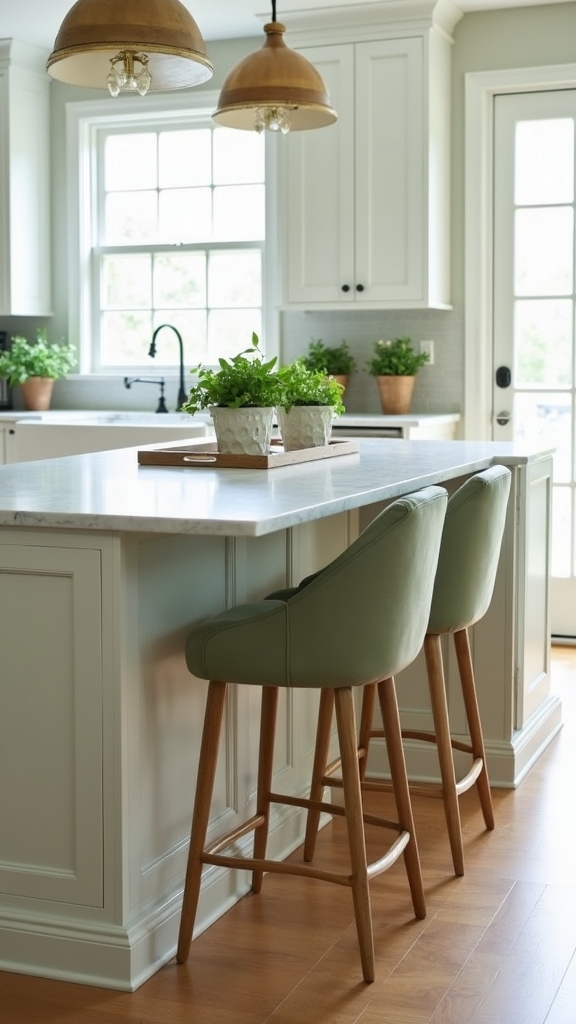
Sage green bar stools serve as both a visual anchor and a practical enhancement for kitchen island seating, blending comfort with design sophistication.
Introducing varied green tones in the stool selection creates depth and a curated, layered aesthetic.
Upholstered options, especially those with ergonomic features, deliver functional comfort without compromising the kitchen’s cohesive style narrative.
Enhancing Kitchen Island Seating
By integrating bar stools in muted green tones, a kitchen island transforms into a functional focal point that encourages both comfort and social interaction.
Sage green bar stools are an expert choice for elevating seating at a sage green kitchen island, delivering a soft green hue that promotes tranquility and timeless style. Their presence supports a cohesive color scheme, seamlessly tying together cabinetry and decor.
- Visual Continuity: Soft green bar stools echo the palette of the kitchen, reinforcing design unity and visual balance.
- Ergonomic Comfort: Plush cushions and sleek frames provide ergonomic support, making the island ideal for casual dining or extended conversation.
- Layered Aesthetic: Varying shades of sage in bar stools introduce depth and sophistication, while maintaining a serene, inviting atmosphere.
Mixing Green Tones Stylishly
A harmonious kitchen palette emerges when multiple green tones are thoughtfully layered, with sage green bar stools serving as both a visual anchor and a source of ergonomic comfort. Successful sage green kitchen ideas rely on mixing various shades of green—think olive, mint, and forest—for refined depth and a curated aesthetic. Sage green bar stools, characterized by sleek lines and plush upholstery, enhance both farmhouse vibe and contemporary design, seamlessly bridging rustic charm and modern sophistication. Their integration allows for flexible styling, encouraging designers to experiment with color gradation and tactile contrasts.
| Shade of Green | Suggested Material |
|---|---|
| Sage | Velvet Cushioned Bar Stool |
| Olive | Matte Ceramic Tile |
| Mint | Painted Cabinetry |
| Forest | Glass Pendant Lighting |
| Moss | Textured Area Rug |
Functional Comfort Meets Aesthetics
When integrated thoughtfully into kitchen layouts, sage green bar stools deliver a synthesis of ergonomic support and visual refinement. Their functional comfort is derived from plush cushions and sleek silhouettes, making them a stylish addition to kitchen decor.
The subtle hue of sage green introduces a calming effect, fostering an inviting environment for both casual meals and lively gatherings. Layering different shades prevents monotony, ensuring the seating area feels dynamic without causing visual clutter. Pairing these stools with natural wood or metallic accents enhances cohesiveness and raises the overall aesthetic.
- Ergonomic Design: Sage green bar stools provide lumbar support and plush seating for prolonged comfort.
- Visual Versatility: The stylish color integrates seamlessly with modern, rustic, or evolving kitchen decor.
- Atmospheric Warmth: Their presence creates an inviting, sociable atmosphere around kitchen islands.
Sage Green Kitchen Islands for Functionality
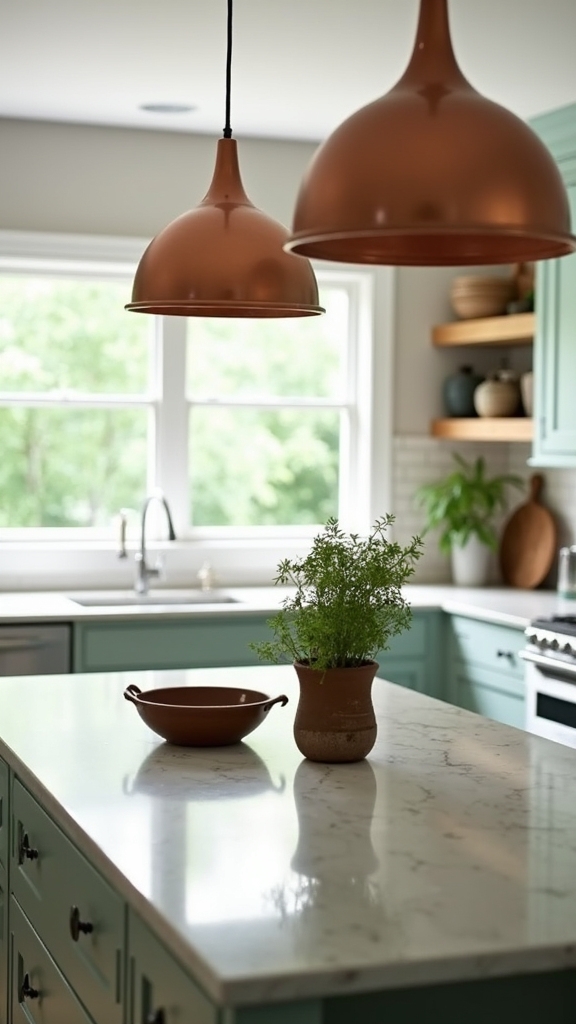
With their ability to anchor the room both visually and functionally, sage green kitchen islands offer expanded workspace and integrated storage solutions that streamline culinary tasks. As a functional centerpiece, these islands enhance the sage green kitchen by providing both utility and an inviting, warm atmosphere. Their subtle hue contrasts effectively with lighter cabinetry, creating depth while maintaining cohesion when paired with matching cabinetry or accents. Sage green kitchen islands are also highly adaptive; they can be customized with a variety of countertop materials to complement the serene color palette. Additionally, they foster a social environment by accommodating bar stools for casual dining. The table below outlines key features:
| Feature | Benefit |
|---|---|
| Integrated Storage | Maximizes organization |
| Expanded Workspace | Enhances functionality |
| Warm Color Palette | Inviting centerpiece |
| Seating Options | Facilitates gathering |
Mixing Sage Green With Wood Elements
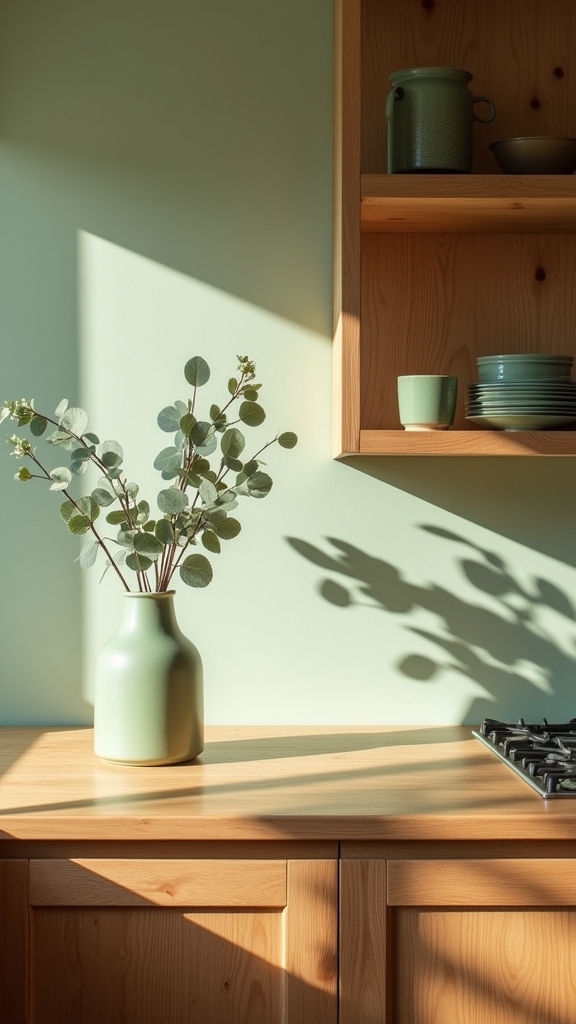
Synergy between sage green and wood elements establishes a kitchen environment rooted in organic sophistication. The subtle coolness of sage green painted cabinetry juxtaposes with the inherent warmth of wood elements, fostering both visual contrast and textural depth. Integrating natural materials such as reclaimed wood beams, butcher block countertops, or floating wooden shelves not only enhances sustainability but also imparts a timeless farmhouse feel. The interplay of these materials raises both modern and traditional kitchens, providing a harmonious blend of chic and cozy. Incorporate large windows for natural light to further enhance the ambiance and create an inviting space.
- Reclaimed Wood Accents: Use reclaimed wood for open shelving or range hoods to introduce rustic charm and eco-friendly character.
- Wooden Countertops: Pair sage green painted cabinets with walnut or oak countertops for tactile richness.
- Farmhouse Elements: Incorporate farmhouse sinks and exposed wood beams for a welcoming, grounded atmosphere.
Sage Green Fabrics and Textiles
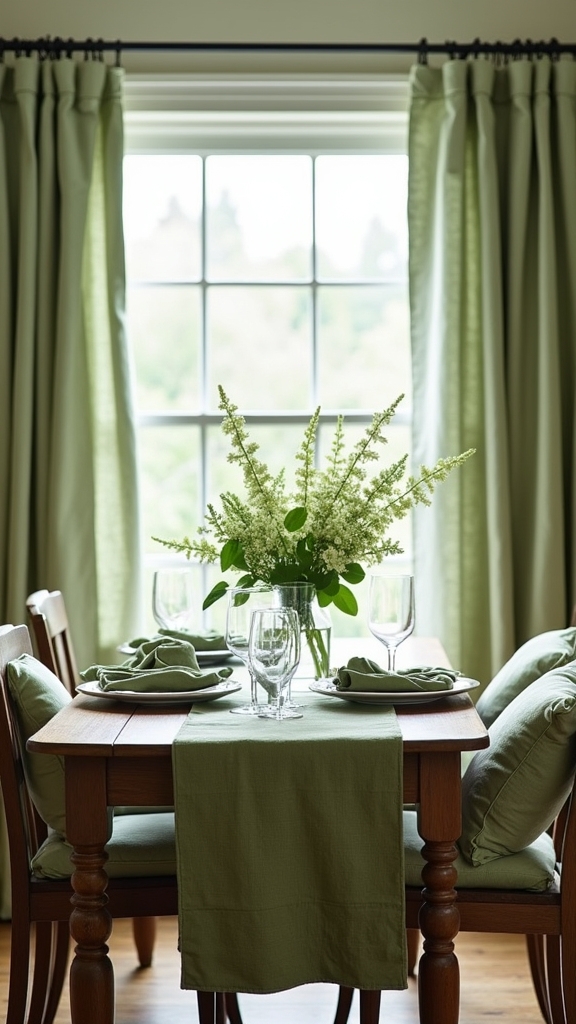
Textiles in sage green introduce a refined layer of softness to kitchen interiors, balancing visual warmth with tactile comfort. Sage green fabrics, such as linen curtains or cotton seat cushions, seamlessly integrate into kitchen decor by enhancing both function and aesthetics.
Their muted tones harmonize with neutral color palettes, reinforcing a serene, understated ambiance. Employing sage green tablecloths or placemats delivers a cohesive dining experience, while diverse fabric textures provide dimensional interest and visual depth.
When paired with natural materials—like wooden chairs or woven baskets—these textiles amplify the organic feel of the space, fostering a grounded, welcoming environment.
Strategic placement of sage green fabrics guarantees the kitchen remains inviting and stylish, without overpowering the overall design scheme or compromising harmony.
Green Kitchen Accessories and Decor

Strategically placed sage accent pieces, such as ceramic vases or minimalist bowls, introduce refined color continuity while maintaining visual restraint.
Integrating natural textures—like wooden boards or herb planters finished in muted green—enhances tactile richness and reinforces a cohesive organic theme. Incorporating greenery, such as potted herbs, adds a natural vibe that complements the sage green decor.
This approach achieves both aesthetic cohesion and functional harmony within the kitchen environment.
Subtle Sage Accent Pieces
Although sage green is often associated with bold cabinetry or walls, incorporating subtle accent pieces provides an effective means of introducing this tranquil hue without dominating the kitchen’s palette.
Expertly curated, subtle sage accent pieces—when integrated with natural wood—create a visual interplay that exudes both sophistication and serenity.
Soft sage green elements, such as dishware and textiles, infuse the space with gentle color while maintaining cohesion and functional elegance.
These carefully selected accents foster visual interest, allowing for seasonal flexibility and effortless updates.
- Sage Green Dishware & Vases: Introduce calm sophistication and can be displayed or used daily.
- Natural Wood Cutting Boards & Herb Pots: Complement soft sage green tones while enhancing organic texture.
- Textile Accents (Curtains, Cushions): Add comfort, warmth, and subtle color for a cohesive, serene environment.
Natural Texture Combinations
Blending sage green kitchen accessories with natural textures introduces layered visual depth and tactile interest, essential for cultivating a serene yet dynamic atmosphere.
Natural textures such as woven baskets, jute or sisal rugs, and soft linen textiles establish a warm, grounded aesthetic. Wood accents—seen in cutting boards, trays, and utensils—integrate seamlessly, as green has become a preferred hue for cabinetry and decor, enhancing the organic synergy.
Ceramic dishware and stoneware or terracotta planters complement sage green elements, forming a cohesive palette that balances color and materiality.
The interplay between these materials and tones not only provides functional durability but also reinforces the tranquil, earthy ambiance, making the kitchen both visually compelling and inviting.
This approach highlights nature’s versatility within contemporary kitchen design.
Sage Green Wall Paint for a Refreshing Look
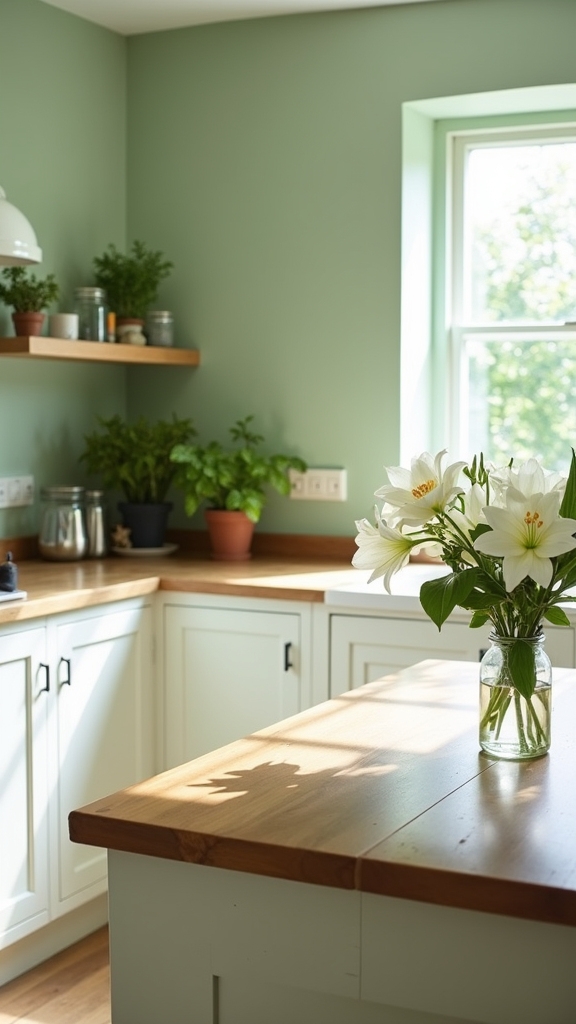
Sage green wall paint introduces a calming, nature-inspired palette that transforms the kitchen into a tranquil and inviting space. Utilizing this hue as a backdrop fosters a revitalizing look while subtly enhancing natural light, resulting in a brighter and more expansive ambiance.
The adaptability of sage green wall paint allows it to seamlessly integrate with a diverse range of cabinetry styles, establishing a cohesive and harmonious look throughout the kitchen. To optimize both visual impact and functional sophistication, consider the following strategies:
Sage green walls effortlessly unify various cabinetry styles, creating a harmonious and visually appealing kitchen environment.
- Pair sage green walls with crisp white or cream trim to achieve striking contrast and refined elegance.
- Leverage the soft undertones of sage to modernize outdated kitchens without extensive renovations.
- Use sage green wall paint to amplify the perception of natural light, making the space feel open and rejuvenating.
Sage Green Flooring Options

Extending the calming effect of sage green beyond the walls, flooring in this versatile hue offers a sophisticated foundation for the kitchen.
Sage green flooring, whether in resilient tiles or low-maintenance vinyl, provides practicality while imparting a subtle elegance. Light sage green flooring visually expands compact kitchens, infusing them with an airy openness, whereas deeper sage tones deliver a striking counterpoint to pale cabinetry.
For added dimension, patterned sage green tiles—such as geometric or hexagonal motifs—introduce visual interest and a contemporary edge without overwhelming the space.
Integrating sage green flooring with matching cabinetry or select accents achieves a cohesive look that harmonizes the entire kitchen. This strategic use of color and pattern enhances both the functional and aesthetic value of the culinary environment.
Sage Green Decorative Accents

Strategic placement of sage green decorative accents, such as ceramics or glassware, introduces nuanced color while maintaining spatial balance within the kitchen.
These elements serve to layer visual interest, linking cabinetry, textiles, and surfaces into a unified aesthetic.
The adaptability of such accents supports seamless updates, allowing for functional yet visually cohesive transformations across seasons.
Incorporating Sage Green Decor
How can a kitchen’s ambiance be enhanced with subtle yet impactful color choices? Sage green emerges as a refined solution, offering both tranquility and sophistication.
Decorative accents in sage green—such as vases, bowls, and framed prints—provide harmonious focal points without disrupting neutral palettes.
Integrating natural elements, like wooden utensils paired with sage green plant pots, infuses warmth and organic texture.
For functional cohesion, textiles in sage green—dish towels, table runners, or oven mitts—soften hard surfaces and unify the scheme.
- Curate Sage Green Accents: Select vases, bowls, and artwork in varying sage tones for layered visual harmony.
- Enhance with Natural Elements: Introduce wooden boards and sage green planters for tactile contrast.
- Utilize Textiles: Coordinate sage green dish towels and runners to seamlessly tie together the decor.
Layering Visual Interest
Building on the cohesive presence established by sage green decor, careful layering of decorative accents introduces nuanced visual interest to the kitchen space. Sage green vases, artwork, and bowls infuse personality while maintaining visual harmony. Strategic placement of these elements, particularly when mixed with varying shades, amplifies visual depth and creates a dynamic, inviting atmosphere. Integrating natural materials—such as wooden cutting boards—provides essential texture, contrasting and softening the green palette. The following table highlights key approaches for layering visual interest with sage green decor:
| Element | Functional Focus |
|---|---|
| Sage Green Vases | Focal point, color continuity |
| Wooden Cutting Boards | Warmth, added texture |
| Layered Artwork | Visual depth, personality |
| Accent Bowls | Subtle style, practical use |
| Mixed Green Hues | Dynamic, cohesive palette |
Green Patterned Tiles for Visual Interest
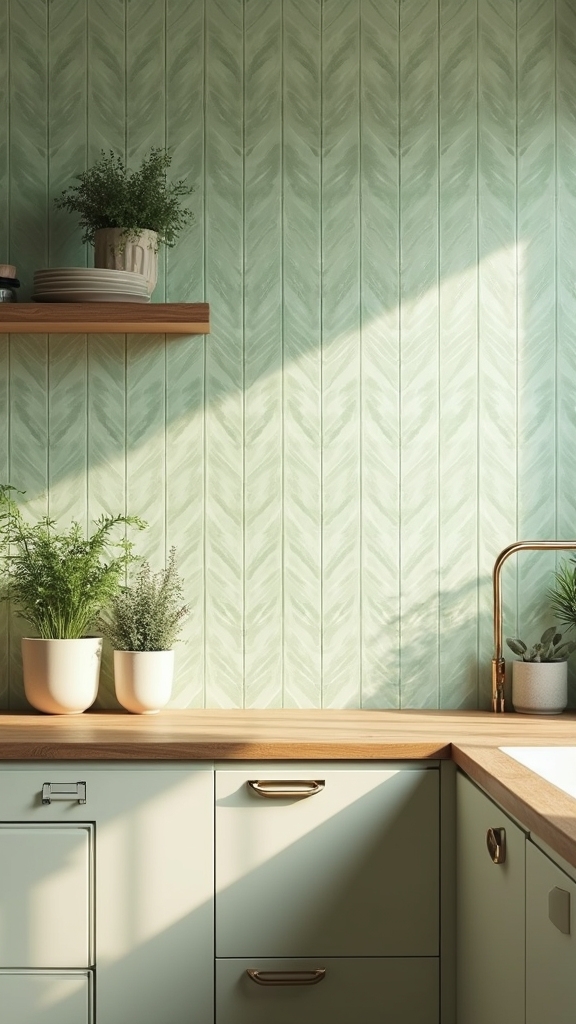
Incorporating butcher block islands into kitchen designs can refresh spaces without extensive renovations, adding warmth and functional versatility.
Sage Green Window Treatments for Soft Light
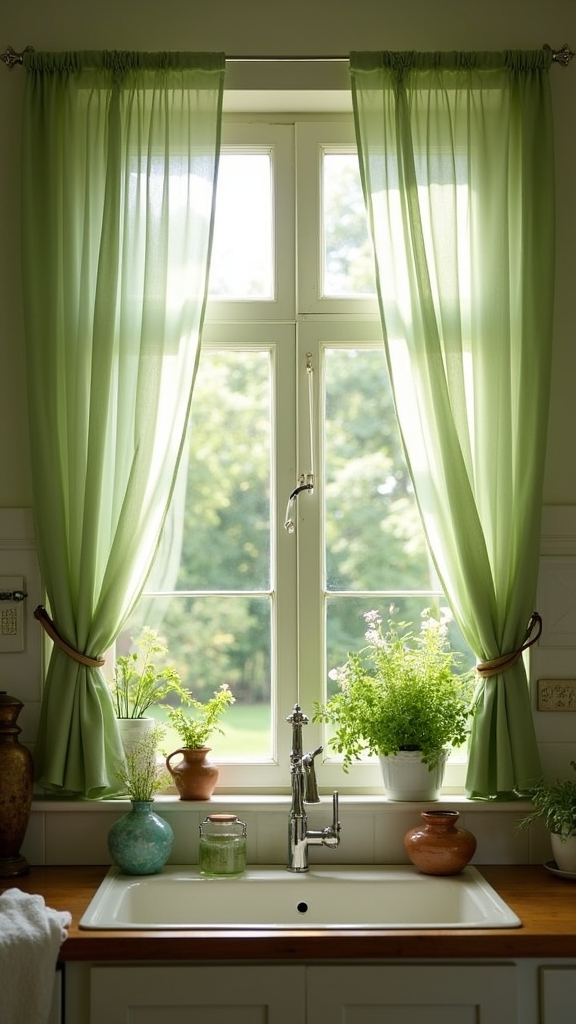
Window treatments in sage green introduce both functional elegance and visual harmony to kitchen spaces.
Sage green window treatments, such as sheer curtains or Roman shades, are expertly suited to diffuse soft light, fostering a serene ambiance while enhancing privacy. The use of lightweight fabrics guarantees that natural illumination permeates the area, preventing harsh glare yet maintaining a breezy, inviting atmosphere.
These treatments become a subtle statement, unifying the kitchen’s color palette, especially when coordinated with sage green cabinetry or accessories. For additional depth, layering sage green curtains with neutral valances or blinds creates visual interest without sacrificing luminosity.
Highly versatile, sage green window treatments seamlessly adapt between modern, transitional, or farmhouse interiors, effortlessly harmonizing with wood, stone, and metallic finishes for a refined, tranquil effect.
Green Kitchen Rugs for a Cozy Touch
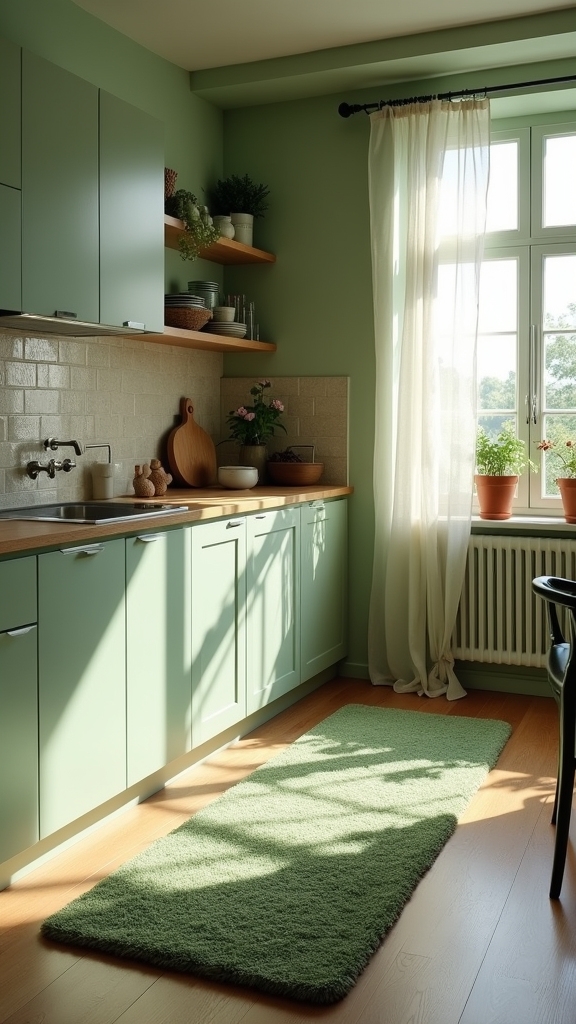
Among the essential elements for infusing warmth and tactile comfort into a kitchen, sage-toned rugs stand out as both decorative and practical assets.
Green kitchen rugs in subtle sage hues deliver a grounded sense of serenity while enhancing the cohesion of sage green decor. Selecting rugs crafted from natural fibers such as jute or cotton optimizes texture and softness underfoot, contributing eco-friendly appeal and everyday usability.
To maximize both visual interest and functional longevity, consider these expert recommendations:
- Choose subtle patterned green kitchen rugs to introduce depth without overwhelming the space.
- Opt for stain-resistant finishes, ensuring the rug maintains its appearance in high-traffic kitchen zones.
- Emphasize a coordinated look by matching green rugs with other accents, like seat cushions or curtains, for harmonious integration.
Sage Green Painted Walls for a Subtle Background
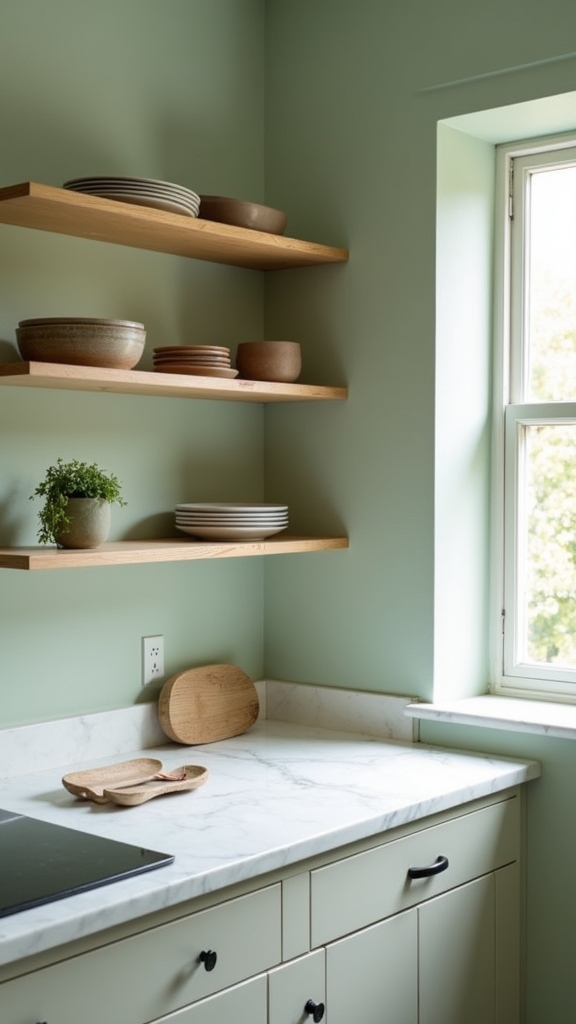
A coat of sage green paint transforms kitchen walls into a tranquil backdrop, diffusing natural light and setting a calming tone for the entire space. This subtle background serves as a versatile canvas, harmonizing with a range of cabinetry—from sleek modern profiles to classic traditional designs.
The painted kitchen walls in sage green interact dynamically with white or cream trim, establishing a crisp contrast that visually expands and brightens the room. Earthy undertones in sage green enable seamless integration of bold accent colors, ensuring that decorative elements stand out without overwhelming the serene ambiance.
For a cohesive aesthetic, continuing sage green across cabinetry and decor unifies the space, reinforcing a sense of order and tranquility foundational to a refined kitchen environment.
Frequently Asked Questions
Is Sage Green Kitchen Decor Easy to Maintain and Clean?
Sage green kitchen decor typically offers moderate color durability and stain resistance. Effective cleaning tips include using gentle, non-abrasive cleaners and incorporating regular maintenance routines to preserve aesthetic integrity, ensuring both ease of cleaning and long-lasting surface appeal.
How Does Sage Green Affect Mood and Energy in the Kitchen?
Color psychology identifies sage green as a hue promoting calming effects and energy balance. Its muted tone fosters design harmony, visually softening kitchen spaces while supporting stress reduction and functional focus, ultimately enhancing occupants’ overall mood and productivity.
What Are the Best Plants to Pair With Sage Green Kitchens?
Selecting the best plants for sage green kitchens involves prioritizing herb pairings like rosemary and basil, which offer culinary utility. For visual color contrasts, consider snake plants or pothos; low-maintenance varieties also serve as practical kitchen accessories enhancing design functionality.
Are There Eco-Friendly Paint Options for Sage Green Kitchens?
Eco-friendly brands offer low-VOC or VOC-free paint finishes, minimizing environmental impact while maintaining durability. Their sage green color palettes provide a sophisticated aesthetic, ensuring ideal coverage and washability. These sustainable solutions integrate seamlessly into modern, function-driven kitchen environments.
Does Sage Green Work Well in Small or Dark Kitchen Spaces?
Sage green enhances small or dark kitchen spaces by providing a soothing palette, especially when paired with strategic kitchen lighting and thoughtful color contrast. This hue fosters design balance, reducing visual clutter while maintaining a sophisticated, functional environment.
Conclusion
Sage green kitchen décor offers a harmonious blend of tranquility and sophistication, seamlessly integrating with both contemporary and classic design schemes. Its subdued yet distinctive hue acts as a versatile backdrop or focal point, enhancing cabinetry, tiles, textiles, and appliances alike. By combining sage green elements with neutral surfaces and textural accents, homeowners can achieve a visually balanced and functionally efficient space, where aesthetic serenity and practical utility coexist—making the kitchen an inviting and enduring centerpiece of the home.
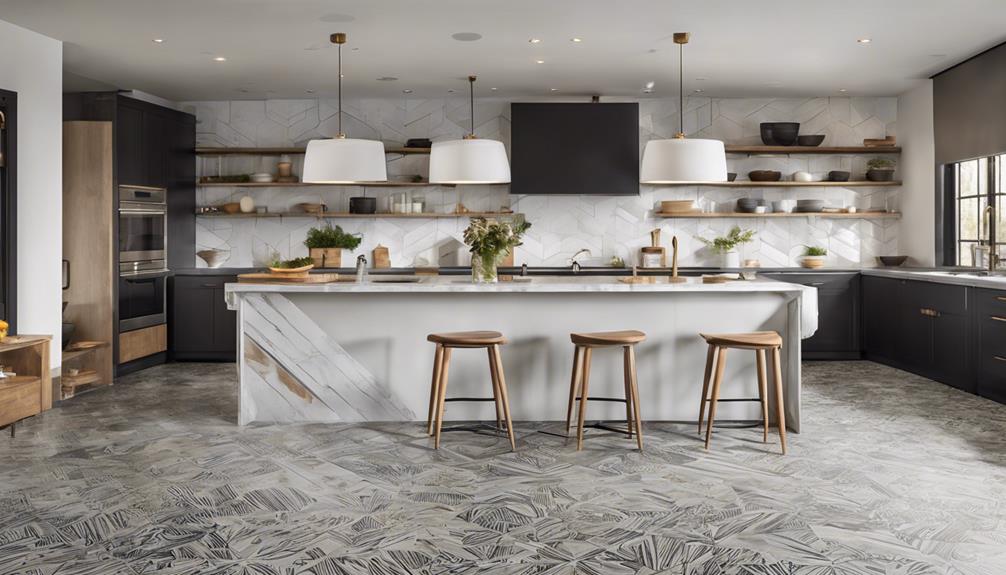
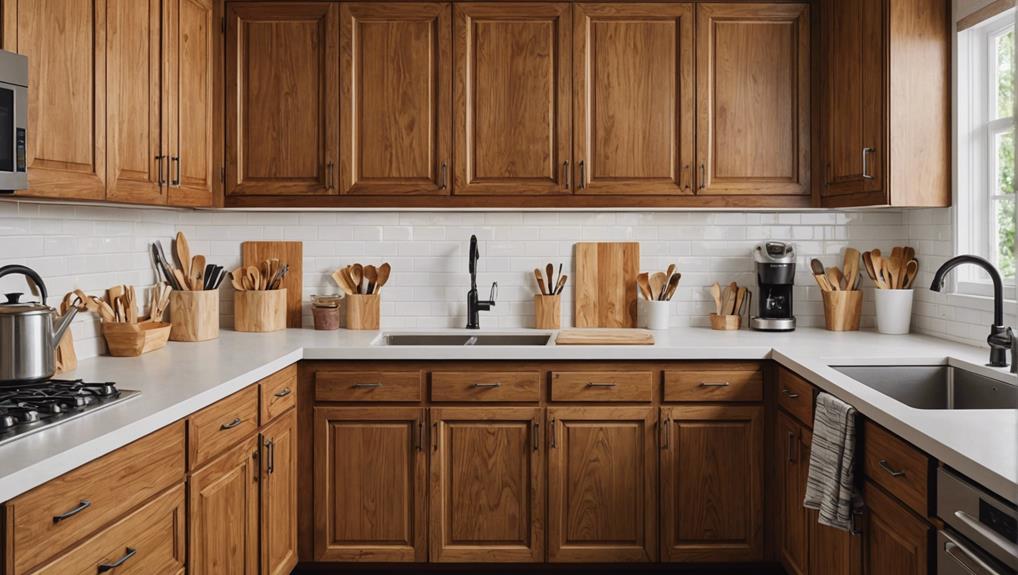
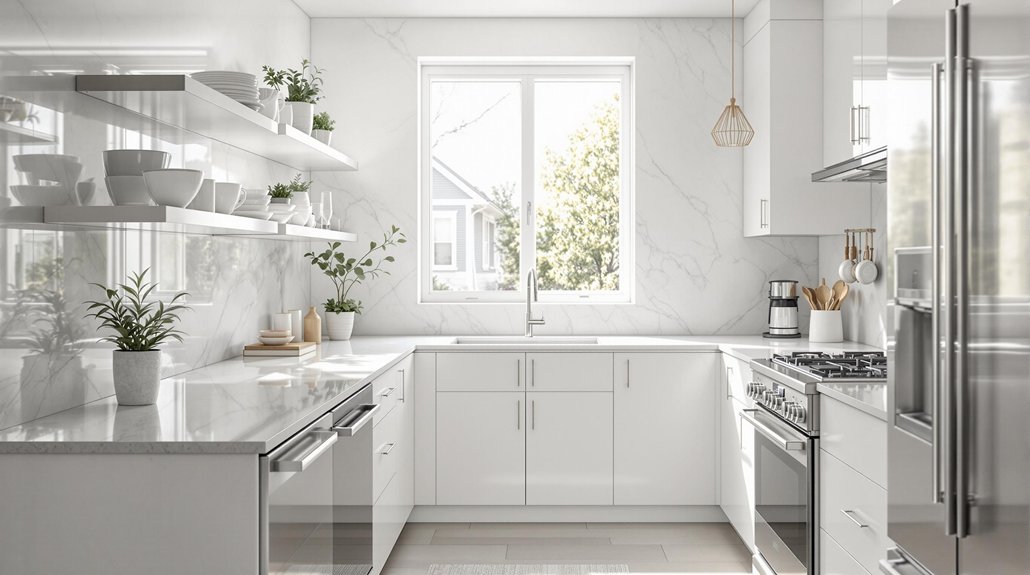
Leave a Reply